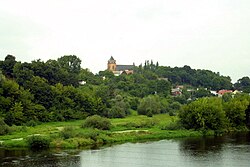Różan
Różan | ||
|---|---|---|
 View with Narew river | ||
|
Car plates WMA | | |
| National roads | ||
| Website | www.rozan.eur.pl | |
Różan intersect in the town.
History

In the late
, which fortified the importance of Rozan as a trade and administrative center.The town prospered until the disastrous Swedish invasion of Poland (1655–1660), when it was ransacked and burned by the invaders. Following the Partitions of Poland and the Congress of Vienna, Rozan in 1815 became part of Russian-controlled Congress Poland, where it remained until World War I. During the January Uprising, clashes between Polish insurgents and Russian troops took place near Różan on April 24 and August 21, 1863.[1] The uprising was widely supported by local residents, and as punishment, in 1870 Russians stripped Różan of its town charter. Nevertheless, Różan was a strong garrison of the Imperial Russian Army, with four forts, built after 1886.

The crossing of the Narew at Różan had significant military importance in the first half of the 20th century. The
After the war, in 1918, Poland regained independence and control of Różan, and town rights was restored in 1919.
During the Polish–Soviet War, the invading Russians captured 13 Polish soldiers in the town and murdered them in the village of Miecze on August 23, 1920.[2] There is a mass grave of the massacred soldiers at the local Catholic cemetery.[2]
Rożan was fortified further before 1939. By 1939, its population grew to 5,800.
World War II
During the German Invasion of Poland, which started World War II in September 1939, Różan was defended by the Polish army.
In the beginning of the German occupation, the occupiers carried out mass searches of homes of local policemen, postal workers and court employees.[3] In November 1940, the German gendarmerie carried out expulsions of Poles, whose houses were handed over to German colonists as part of the Lebensraum policy.[4]
At the outbreak of
In the course of the fighting in 1944, the
References
- ^ Zieliński, Stanisław (1913). Bitwy i potyczki 1863-1864. Na podstawie materyałów drukowanych i rękopiśmiennych Muzeum Narodowego w Rapperswilu (in Polish). Rapperswil: Fundusz Wydawniczy Muzeum Narodowego w Rapperswilu. pp. 232, 246.
- ^ ISSN 1427-1443.
- ^ Wardzyńska, Maria (2009). Był rok 1939. Operacja niemieckiej policji bezpieczeństwa w Polsce. Intelligenzaktion (in Polish). Warszawa: IPN. p. 112.
- ISBN 978-83-8098-174-4.
- ^ "Pinkas Hakehillot Polin: Rozan". www.jewishgen.org.
External links
- Jewish Community in Różan on Virtual Shtetl
- 1:25,000 topographic map from 1940

